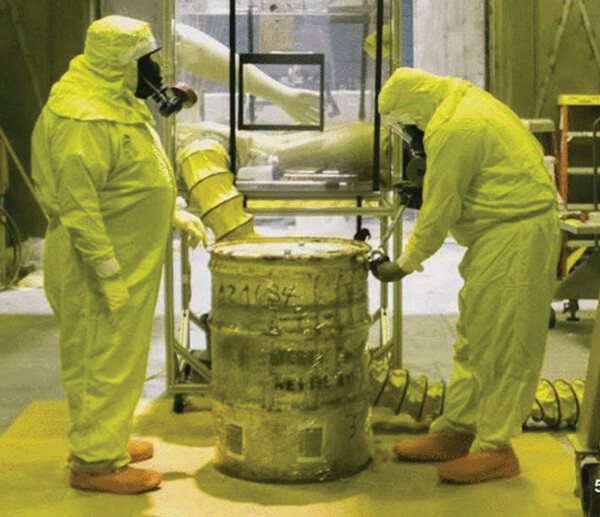News & Articles
Browse all content by date.

This week’s explosive news from cheap, clean, safe nuclear power is that three barrels of unspecified “radioactive material” either ruptured or burst or exploded at the Idaho National Laboratory (INL), near Idaho Falls, on April 11. “An exothermal event” is how Department of Energy (DOE) spokesperson Danielle Miller described the prompt deconstruction of the rad waste barrels.
“Exothermal” is a nice distraction that means “a chemical reaction accompanied by the release of heat.” The “don’t call it an explosion” usage reminds me of the potentially catastrophic detonation of hydrogen gas in a loaded high-level waste cask at Wisconsin’s Point Beach reactor site, May 28, 1996. According to the Nuclear Regulatory Commission’s initial report, gas ignited inside the fully-loaded cask containing 14 tons of highly radioactive used reactor fuel at 2:45 a.m. The explosion lifted the cask’s 4000-pound lid and left is askew. The reactor people’s inventive PR department called that one a “gaseous ignition event.”
The Idaho Lab explosion story was reported by the Associated Press, the Seattle Times, ABC News, the Japan Times, and Fox Radio news among others. So far the people at INEL have said three 55-gallon drums of radioactive “sludge” from the long-shutdown Rocky Flats, Colorado plutonium bomb factory “ruptured.”
Unfortunately for those who responded and put out the smoldering barrels, Associated Press reported April 12, “When the firefighters left the building emergency workers detected a small amount of radioactive material on their skin.”
The very next sentence in this AP story was that the DOE’s Miller said, “None of the radioactive material was detected outside of the building where the rupture occurred” -- except for what was found on the contaminated firefighters, she forgot to say.
Because of decades of “secretive record-keeping” finding out what is in the barrels or on the firefighters is tough. Officials do not “know the exact contents,” INEL’s Joint Information Center spokesman Don Miley reportedly said.
One reported “theory” about the explosion’s cause, according to the Associated Press, is that “radioactive decay made the barrel[s] heat up and ignite particles of uranium.” This “theory” has been around a long time and can now be considered something of an explanation. For example, in 1995 when government geniuses were targeting Yucca Mountain, Nevada for a permanent abandonment site for all of the industry’s high-level radioactive waste fuel (80,000 tons), physicists Charles Bowman and Francesco Venneri at the Los Alamos National Laboratory reported that waste might erupt in a massive explosion scattering radioactivity to the winds and into groundwater. Former DOE geologist Jerry Szymanski said of the finding, “You’re talking about an unimaginable catastrophe. Chernobyl would be small potatoes.”
Back at the Idaho Lab’s exothermal event, spokesman Don Miley told the press, “They haven’t run into anything like this actually happening.” But Miley has a short memory. It just happened four years ago, on Valentine’s Day 2014, at the DOE’s Waste Isolation Pilot Plant in Carlsbad, New Mexico. A barrel of plutonium waste exploded underground, contaminating the entire underground facility, including elevator and ventilator shafts, and poisoned at least 22 workers who inhaled the plutonium-laced dust.
More recently, on October 18, 2015, a waste trench fire and explosion, spurred by rainfall, hurled 11 buried barrels of waste metallic sodium in the air and spewed debris like a geyser 60 feet into the air, at the US Ecology, Inc. site near Beatty, Nevada. The shocking 2015 fire, in one of the 22 shallow trenches of low-level radioactive waste there, couldn’t be put out with fire hoses because water had started it in the first place. Instead, authorities closed nearby US Highway 95 for a day, cancelled school, and just waited nervously for more explosions as the chemical waste fire burned itself out. US ecology had its records confiscated by the Nevada Radiation Control Program, which has never disclosed what sorts of radioactive materials were in the burned and exploded Trench 14 -- although the trenches altogether are known to hold 47 pounds of plutonium and uranium isotopes.
The Idaho Lab barrels reportedly contain a mixture of fluids and solvents and were shipped from the Rocky Flats plutonium weapons production site near Denver, AP reported April 13. The name Rocky Flats should have rung a bell for INL’s Don Miley who is betting we were all born yesterday.
Plutonium bomb fabrication at Rocky Flats caused the second largest industrial fire in US history. On September 11th, 1957 (right?), this ghastly blaze howled for over 13 hours and consumed two tons of plutonium. Filters designed to trap ash and particles were all destroyed by the fire, so between 30 and 44 pounds of respirable plutonium-239 and plutonium-240 escaped through chimneystacks, contaminating parts of Denver and its surroundings. “When smokestack monitors were reconnected seven days after the fire, radioactive measurements were 16,000 times greater than ‘allowable’ standards,” Helen Caldicott notes in her revised edition of Nuclear Madness. No emergency response was taken to protect the people of Denver.
Not much has changed since 1957 for people downwind of dumpsites, bomb factories, or today’s national labs — or for the INEL first responders. “They got some radioactive contamination on their skin, but emergency workers washed it away,” the DOE’s Danielle Miller reportedly said, and “the firefighters did not inhale any of the radioactive material.” Miller can’t possibly know this, but it sounds good, and it might even be true since one’s nose and mouth are so far from the skin.
| Tweet |

